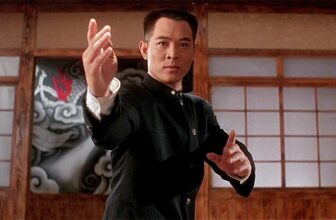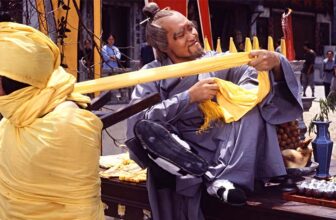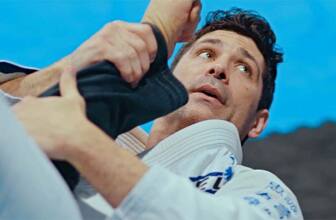
Jackie Chan’s sequel to his smash hit 1978 original kung fu comedy. “Drunken Master II” sees Chan as Wong Fei Hung getting mixed up in a scam to smuggle ancient Chinese treasures out of the country.
Trailer
Cast
Hong Kong superstar Jackie Chan reprises his role as “Wong Fei Hung”, turning history on it’s head to play the character as the unruly master of Drunken Boxing.
Jackie Chan’s friend and frequent co-star, the late, great actress and singer Anita Mui, plays Wong Fei Hung’s mother “Ling”. In reality, Anita Mui was nine years younger than Jackie! “A Better Tomorrow” star Ti Lung, at just eight years older than Jackie, plays Wong Fei Hung’s father, “Wonk Kei Ying”. Shaw Brothers legend Lau Kar Leung not only stars as “Master Fu Wen-Chi”, but also directed the film.
Jackie Chan’s former bodyguard Ken Lo plays the super-kicking henchman “John”. Stuntman Ho Sung Pak, “Liu Kang” in the “Mortal Kombat” arcade games, plays John’s fellow henchman, “Henry”. There are cameos from popular Hong Kong actors Andy Lau, Bill Tung, Chin Gar Lok and Felix Wong.
Plot
Set in early 1900’s, Wong Fei and his father Dr. Wong Kei Ying, are travelling home by train. Disobeying his father, Fei Hung hides some ginseng in the suitcase of an employee of the British consul to avoid paying tax. When Fei Hung attempts to retrieve the ginseng, he spots a man, Master Fu Wen-Chi, apparently stealing the ginseng. After a running battle with the man, Fei Hung retrieves what he thinks is his package. When Master Fu Wen-Chi opens the parcel he stole from the train, he discovers that he in fact has the ginseng. Meanwhile, Fei Hung is shocked to find that he has accidentally stolen a valuable Chinese antique, the Emperor’s Jade Seal.
The corrupt British ambassador, who is selling stolen ancient Chinese artefacts to the London Museum of Arts, tells his henchman that they won’t buy the collection of antiques without the missing Emperor’s Jade Seal.
When Fei Hung’s mother, Ling realises he has lost the ginseng, she decides to temporarily loan her necklace to one of her friends in exchange for some money to buy some more ginseng, thus saving Fei Hung from his father’s wrath. Mistakenly Wong Kei Ying’s friends now think he is having financial troubles, and they offer him a collection, which a confused Master Wong declines.
Henry and his gang of henchmen follow Fei Hung and his mother believing that Ling has the Emperor’s Jade Seal, and attempt to steal the bag, which actually contains her necklace. Fei Hung defeats them with his drunken boxing, but Wong Kei Ying arrives as the fight ends. Master Wong believes that the family’s good reputation is being ruined by Fei Hung’s behaviour. Master Wong disowns Fei Hung and expels him from the family home.
Henry, joined by John and the rest of his henchmen, find Fei Hung drowning his sorrows. Too drunk to defend himself, the gang beat Fei Hung and string him up in the town centre with a sign that reads “King of Drunken Boxing.” Master Wong brings Fei Hung back into the home, and explains that the reason why he forbids drunken boxing is because it is difficult for drunken boxers to find the right balance of alcohol consumption.
Master Fu Wen-Chi, eventually finds the Wongs, and Fu explains to Fei Hung about the theft of precious Chinese artefacts by foreigners and asks them to help him in stopping the trade. However, the pair are attacked by a gang of axe-wielding thugs and the British retrieve the Jade Seal.
Fei Hung teams up with the townsfolk and steelworkers who have been oppressed by the gang. To stop their greedy scheme, Wong Fei Hung must use all his skills and become drunker than ever to succeed!
Action
For fighting action, “Drunken Master II” is usually near the top of most Jackie Chan fans’ all-time favourite lists.
Jackie Chan was taking a bit of a risk returning to the traditional style of kung fu film that had established him as a star some sixteen years earlier. In the early nineties, the “new wave” of wuxia (martial hero) films, epitomised by the “Once Upon A Time in China” series, were the most popular martial arts movies. His film immediately preceding this one was the tough and serious action drama “Crime Story”. For the action in “Drunken Master II”, Jackie wanted to return to traditional choreography and his trademark comedy. To that effect, he recruited the Shaw Brothers legend Lau Kar Leung to direct the movie.
Our first action scene involves Jackie fighting real-life Hung Gar Master Lau Kar Leung. Beginning underneath a train carriage and the wooden station platform, the cramped conditions do not restrict the incredible technique, timing and speed of our two stars, with Lau Kar Leung using a spear against Jackie’s broadsword. The fight eventually opens out into a country barn, where the weapons are put to one side to see who’s fist technique is best. Here, Jackie gives a glimpse of his famous drunken style. Lau Kar Leung also demonstrates that age is not a barrier, and he is no slouch with his solid technique against the young pretender.
Whilst shopping in the market, Fei Hung is challenged by the fishmonger, played by Felix Wong. Here Jackie has more space to adopt a more old-school style of kung fu fighting. Fei Hung is tempted to use his drunken fist, and we get fleeting glimpses of it, but he restrains himself. Felix Wong is a good opponent, fighting in a traditional fist style, with nice stance work and technique.
It is not long before the fans get what they are waiting for. Initially fighting off a bunch of thugs in a “sober-style”, Fei Hung’s mum encourages him to use his drunken boxing to impress the gathering crowd. To help him hit his stride, his mum throws bottles of wine to Fei Hung. The more he drinks, the faster and more agile he becomes. Jackie’s energy and skill are sublime in this scene. Every sequence of techniques has a wonderful rhythm and flow. He also incorporates a lot of the comedy that made the fights in his 1978 original such fun.
Ti Lung as Fei Hung’s father, Wong Kei Ying, only gets one chance to display his skills in a short sequence with Lau Kar Leung’s Master Fu. It’s a shame that two veterans from the old school don’t get a chance for a more extended scene.
When Fei Hung and Master Fu team up, they are attacked in huge numbers by an axe-wielding gang in a two-storey tea house. The stunt work involved here is quite astonishing considering the sheer numbers of stuntmen on screen at any one time flipping, high-falling, and taking and delivering punches and kicks. Lau Kar Leung delivers the strong fists and sturdy kung fu stances, whilst Jackie brings his familiar innovation of using the walls, stairs, chairs and tables within his choreography.
The conclusion of the film takes place in a steelworks. By this stage of making the film, Jackie and Lau Kar Leung could not agree on the style of directing and Lau Kar Leung left the production, with Jackie taking over. I think it shows in the choreography, although not to the film’s detriment. Jackie initially fights a chain-wielding thug using some delightful traditional techniques. The footage has brief flashes of slow motion photography so we can see the precision and application of some of these techniques. Being a steelworks, there are plenty of hazards, most of them flammable, to give a sense of peril for our hero.
As Jackie progresses through the steelworks, we see him juggle and twirl poles and sledgehammers, and witness his incredible timing as he is nearly crushed by falling barrels. Famous for performing his own stunts, Jackie also does several fire burns, and falls across hot coals on his hands and feet.
The best thing about the finale though is that just like in 1978 against Hwang Jang Lee, Jackie has a worthy opponent in Ken Lo. This scene is arguably Ken Lo at his best, delivering a great acting performance as well as his incredible kicking skills. His kicks are flexible, fast and precise. In order to cope, Fei Hung drinks industrial alcohol sending him, and Jackie’s choreography, over the edge. In most martial arts fights you may get one or two moves that make the audience widen their eyes and mouths in appreciation. For the conclusion of this fight, Jackie pulls out all the stops with every move becoming faster and more furious. There are flips, kip ups, handstand kicks, and incredible hand techniques, all flowing seamlessly together.
As with most Jackie Chan films, the end credits reveal some of the funny and more painful moments that occurred during the making of the film.
Clip: Jackie gets drunk as a skunk to beat the bag snatchers!
Summary
Is “Drunken Master II” Jackie Chan’s best film? It’s a tough question to answer, and I am sure it is at the top of many fans’ lists. The plot line is pretty thin, and much of the humour, especially to a non-Chinese audience, is pretty broad. There are some of the usual Jackie Chan Stunt Team high falls and flips, but they are easily put in the shade when compared to films like “Armour of God” or “Police Story”.
The acting performances are pretty good, especially from old hands like Ti Lung and Lau Kar Leung, and Anita Mui steals every comic scene she is in.
The reason this film is a favourite is all about Jackie Chan’s drunken boxing choreography. The original 1978 version was filmed much in the style of the time; fights with a staccato rhythm and fairly rigid movements, and plenty of techniques that fans of the genre were already familiar with, from movies like “Snake in the Eagle’s Shadow”.
In “Drunken Master II”, each fight scene has a fluid rhythm, and for the drunken boxing scenes, we are treated to a fighting style that is quite unique and different to other martial arts movies. Watching Jackie perform each sequence is like watching Gene Kelly dance at his peak. Jackie hadn’t performed traditional kung fu to such an extent since 1982’s “Dragon Lord”, and when you first see “Drunken Master II”, it doesn’t just hark back to the old school, it sets a new benchmark.
Jackie’s falling out with Lau Kar Leung might actually have worked in the film’s favour. Among their disagreements, Lau had a particular style of filming which involved quick tracking shots, slow-motion and the use of wide-angle lenses to play with perspective, which Jackie didn’t like. Lau wanted to have more of the realistic Hung Gar style of fighting, whereas Jackie felt the fans wanted more of the drunken style. Lau also wanted to use wires extensively in the fight scenes, which Jackie was categorically opposed to. Lau eventually left the film, with Chan taking over as director for the final fight scene. As each fight scene progresses to the concluding fight, the choreography likewise progresses; from the traditional style to the fast and furious crescendo of Jackie Chan’s drunken boxing.
Is “Drunken Master II” Jackie Chan’s best film? Probably not, but in terms of traditional fight choreography and replay value, it’s a right rollicking gem and a tough act to beat!
Trivia
- Lau Kar Leung was a martial arts master who studied Hung Gar under Lam Sai Wing, a student of the real Wong Fei Hung.
- “Drunken Master II” broke box office records in Hong Kong, grossing HK$40,971,484. The success was somewhat surprising, considering that the popularity of kung fu films was waning. Six years later, the film was released in 1,345 North American theatres as “The Legend of Drunken Master”, grossing US$3,845,278 in its opening weekend, on its way to a US$11,555,430 total.
- The fight at the end was originally to be against Ho Sung Pak, but Sung Pak injured his ankle. Instead, Chan fought his personal bodyguard Ken Lo.
- Although Jackie Chan and Lau Kar Leung fell out during filming, Chan refused a director’s credit and has since said he owes a debt of gratitude to Lau Kar Leung for the movie’s success.
- The fighting moves for the character “Shun Di” in Sega’s arcade game “Virtua Fighter 2”, were based on the “Drunken Master” movies.
- Which version to watch? An uncut release with good picture quality, the original audio track, and the original aspect ratio is considered a “holy grail” by many Hong Kong cinema fans. The film’s purest version can only be found on now out-of-print releases, the Mei Ah VCD and LaserDisc, Tai Seng’s VHS (itself a recording of the Mei Ah LaserDisc) and the Australian VHS from Chinatown.
- These prints have “burnt-in” Chinese/English subtitles. The original Thakraal Region 0 DVD release of “Drunken Master II” is the only version which features the entire Hong Kong version. However, the aspect ratio is cropped to 1.78:1 from the original theatrical 2.35:1 aspect ratio.
- The North American theatrical version, titled “The Legend of Drunken Master” was edited. A scene in which Wong drunkenly sings at a café was re-cut slightly, making use of a few alternate takes not seen in the original Cantonese version. In addition, a 35 second cut was made to the concluding scene of the film which showed Wong blinded and mentally crippled as a result of drinking industrial alcohol during the film’s ultimate fight. Played for laughs, the scene was considered to be in bad taste by the American distributor. In addition to the cuts there was a new English-language dub (Jackie Chan dubbed himself), and a new musical score. The re-dubbed soundtrack also meant that sound effects were different, in some instances completely altering the rhythm of the fight scenes.
- The Australian (Region 4) and Japanese (Region 2) releases featured the same cuts and re-scoring as the U.S. release. The Region 3 releases for Hong Kong and Korea contains the English export version with the original 2:35:1 non-anamorphic aspect ratio. This cut of the film ends almost immediately after Fei-Hung defeats John.
- The audio tracks include abridged Cantonese and Mandarin soundtracks, and the original Golden Harvest English dub, which is different to that of the U.S. release. It contains the original score and sound effects, but there are no English subtitles. A Blu-ray version was released on 15th September 2009 in the U.S., which features the cut American version in the original 2.35:1 aspect ratio, but the best picture quality.
- In the U.K. it was released on Blu-ray 16th April 2012 also under the title “The Legend Of Drunken Master”. No DVD has been made available to date that preserves the original aspect ratio and the uncut version of the film with the original Cantonese audio track.






